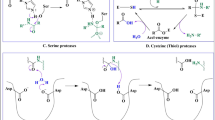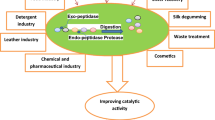Abstract
Various industrially used protein substrates were hydrolysed by a recently constructed, thermally stable, thermolysin-like protease variant (Boilysin; Van den Burg et al., Proc. Natl. Acad. Sci. 95: 2056–2060) and three industrial protease preparations. Hydrolysates were analysed by measuring the acid-soluble products and by SDS-PAGE of the breakdown products. The rate and extent of hydrolysis obtained by Boilysin was, in most cases, higher than those obtained with the three commercially available enzyme preperations tested. This suggests that protein hydrolysis with this new protease variant at elevated temperatures can result in improved substrate conversions.
Similar content being viewed by others
References
Adams MWW, Perler FB, Kelly RM (1995) Extremozymes: expanding the limits of biocatalysis. Biotechnology 13: 662–668.
Adams MWW, Kelly RM (1998) Finding and using hyperthermophilic enzymes. Tibtech 16: 329–332.
Agard DA (1993) To fold or not to fold.... Science 260: 1903–1904.
Arnold FH (1998) When blind is better: protein design by evolution. Nature Biotechnol. 16: 617–618.
Eijsink VGH, Veltman OR, Aukema W, Vriend G, Venema G (1995) Structural determinants of the stability of thermolysin-like proteases. Nature Struct. Biol. 2: 374–379.
Fujii M, Takagi M, Imanaka T, Aiba S (1983) Molecular cloning of a thermostable neutralprotease gene from Bacillus stearothermophilus in a vector plasmid and its expression in Bacillus subtilis. J. Bacteriol. 154: 831–837.
Holmes MA, Matthews BW (1982) Structure of thermolysin refined at 1.6 Å resolution. J. Mol. Biol. 160: 623–639.
Holt C, Sawyer L (1988) Primary and predicted secondary structures of the caseins in relation to their biological functions. Protein Eng. 2: 251–259.
Keay L (1969) Neutral proteases from the genus Bacillus. Biochem. Biophys. Res. Commun. 36: 257–265.
Kuchner O, Arnold FH (1997) Directed evolution of enzyme catalysts. Trends Biotechnol. 15: 523–530.
Laemmli UK (1970) Cleavage of structural proteins during the assembly of the head of bacteriophage T4. Nature 227: 680–685.
May SW (1992) Biocatalysis in the 1990s: a perspective. Enzyme Microbiol. Technol. 14: 80–84.
May SW (1997) Biochemical engineering. Curr. Opinion Biotechnol. 8: 181–186.
Mosimann S, Meleshko R, James MNG (1995) A critical assessment of comparative molecular modelling of tertiary structures of proteins. Proteins Struct. Funct. Genet. 23: 301–317.
Rao MB, Tanksale AM, Ghatge MS, Deshpande VV (1998) Molecular and biotechnological aspects of microbial proteases. Microbiol. Mol. Biol. Rev. 62: 597–635.
Rubingh DN (1997) Protein engineering from a bioindustrial point of view. Curr. Opinion Biotechnol. 8: 417–422.
Sander C, Schneider R (1991) Database of homology-derived protein structures and structural meaning of sequence alignment. Proteins Struct. Funct. Genet. 9: 56–68.
Stemmer WPC (1994) Rapid evolution of a protein in vitro by DNA shuffling. Nature 370: 389–391.
Van den Burg B, Dijkstra BW, Vriend G, Van der Vinne B, Venema G, Eijsink VGH (1994) Protein stabilization by hydrophobic interactions at the surface. Eur. J. Biochem. 220: 981–985.
Van den Burg B, Vriend G, Veltman OR, Venema G, Eijsink VGH (1998) Engineering an enzyme to resist boiling. Proc. Natl. Acad. Sci. USA 95: 2056–2060.
Veltman OR, Vriend G, Middelhoven PJ, Van den Burg B, Venema G, Eijsink VGH (1996) Analysis of structural determinants of the stability of thermolisin-like proteases by molecular modelling and site-directed mutagenesis. Protein Eng. 9: 1181–1189.
Vriend G (1990) WHAT IF; a molecular modelling and drug design program. J. Mol. Graphics 8: 52–56.
Vriend G, Eijsink VGH (1993) Prediction and analysis of structure, stability and unfolding of thermolysin-like protease. J. Comput.-Aided Molec. Design. 7: 367–396.
Author information
Authors and Affiliations
Rights and permissions
About this article
Cite this article
Van den Burg, B., de Kreij, A., Winkel, C. et al. Hydrolysis of industrial substrates by an extremely stable thermolysin-like protease variant obtained by protein engineering. Biotechnology Letters 21, 537–542 (1999). https://doi.org/10.1023/A:1005567122251
Issue Date:
DOI: https://doi.org/10.1023/A:1005567122251




